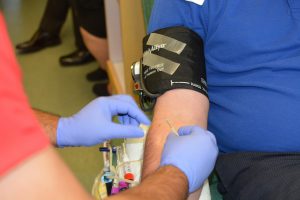In honor of World Red Cross Day (5/8) and International Nurse Appreciation Day (5/12), we want to highlight the innumerable benefits and (relatively!) painless process of giving blood. To locate a blood drive near you, please visit the Red Cross’s blood drive finder.

Benefits
While there are feel-good benefits of giving back by donating blood, blood donations are also vital for our healthcare system. They are essential for emergency rooms treating trauma patients, as well as for medical facilities performing surgeries and transplants, or treating blood disorders and cancers. One single blood donation supplies enough blood for between 1 and 4 patients. When donating blood, you can choose between a “whole blood donation” (which includes all red cells, plasma, and platelets), or an “apheresis donation”, (which includes only one component of your blood, with the rest being returned to your body). You can donate blood every 8 weeks, up to 6 times a year.
Eligibility

Doctors and Nurse Practitioners at the donation site will screen you for the following criteria:
- You must be 18 years old or have parental permission if you’re 16 or 17. There is no age cap for donors.
- You must weigh 120 pounds or more.
- You need a valid driver’s license or a passport for identification.
- You must be free of any major organ disease, including heart disease, lung disease and bleeding tendencies.
- You must not be taking antibiotics or other supplements that could influence the donation.
- You must wait 12 months if you have gotten a tattoo in a state that does not regulate tattoo facilities, including the District of Columbia, Georgia, Idaho, Maryland, Massachusetts, Nevada, New Hampshire, New York, Pennsylvania, Utah and Wyoming.
The Process
The entire process of giving blood takes less than one hour. You will first meet with a nurse practitioner for a quick physical examination and blood pressure check. They will then insert the needle and draw your blood into vials. The usual donation volume is approximately 1 pint. Following the blood draw your nurse will encourage you to sit for 10-15 minutes and have a small snack or drink to ensure you don’t leave feeling lightheaded.
Pain Levels

While you might feel a small, uncomfortable prick when the needle is inserted, you shouldn’t feel any pain while the blood is being drawn. If you are concerned about pain after the procedure you might consider taking an over-the-counter pain reliever to manage the soreness. There’s a slight chance that you will experience weakness in the arm blood was drawn from, so try to avoid physical activity or heavy lifting for the next few hours.
There is always a need for blood donors in this country! Your donation can save a life, so talk to your doctor about your individual health situation if you wish to give blood.